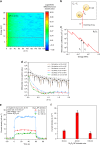High sensitivity organic inorganic hybrid X-ray detectors with direct transduction and broadband response
- PMID: 30050037
- PMCID: PMC6062530
- DOI: 10.1038/s41467-018-05301-6
High sensitivity organic inorganic hybrid X-ray detectors with direct transduction and broadband response
Abstract
X-ray detectors are critical to healthcare diagnostics, cancer therapy and homeland security, with many potential uses limited by system cost and/or detector dimensions. Current X-ray detector sensitivities are limited by the bulk X-ray attenuation of the materials and consequently necessitate thick crystals (~1 mm-1 cm), resulting in rigid structures, high operational voltages and high cost. Here we present a disruptive, flexible, low cost, broadband, and high sensitivity direct X-ray transduction technology produced by embedding high atomic number bismuth oxide nanoparticles in an organic bulk heterojunction. These hybrid detectors demonstrate sensitivities of 1712 µC mGy-1 cm-3 for "soft" X-rays and ~30 and 58 µC mGy-1 cm-3 under 6 and 15 MV "hard" X-rays generated from a medical linear accelerator; strongly competing with the current solid state detectors, all achieved at low bias voltages (-10 V) and low power, enabling detector operation powered by coin cell batteries.
Conflict of interest statement
The authors declare no competing interests.
Figures






References
-
- Milbrath, B. D. et al. Radiation detector materials: An overview. J. Mater. Res.23, 2561–2581 (2008).
-
- Podgorsak EB. Radiation oncology physics: a handbook for teachers and students. Br. J. Cancer. 2008;98:1020. doi: 10.1038/sj.bjc.6604224. - DOI
-
- Takahashi T, Watanabe S. Recent progress in CdTe and CdZnTe detectors. IEEE Trans. Nucl. Sci. 2001;48:950–959. doi: 10.1109/23.958705. - DOI
Publication types
Grants and funding
LinkOut - more resources
Full Text Sources
Other Literature Sources

